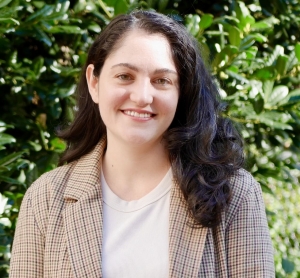
JILL SHOMER
What is the best part about teaching the Core Curriculum?
Community. Something I talk to my students about early on is that this is a discussion-based class; it’s not a lecture. And to be in conversation, we have to build a community where we feel comfortable doing that — and it’s an active, collaborative process. There has to be some buy-in for us to build this community together.
And you know, they’re all coming from different backgrounds. So it’s about helping them get to a point where they’re all in the classroom together and really listening to each other — valuing each other’s perspectives, feeling vulnerable enough to share what they think, and questioning their initial reactions to the text. I think that’s so important — especially in the current political climate — to have a space where students feel like they’re being listened to.
There’s also a lot of initiative by the Center for the Core Curriculum to have events and presentations for us as instructors. I’ve met so many people across departments and from the other Core courses. We get together and talk about pedagogy, and about the challenges we run into as instructors. Everyone is really dedicated to their students! It’s nice to have that community inside and outside the classroom.
How do you innovate and/or bring your own spin to Lit Hum?
I like to ask my students to do a creative project for the end of each semester. Sometimes I’ve noticed a little hesitancy about that — students often want to go with what’s familiar, like writing a paper. It can be hard to ask them to share something creative if they’re not used to it.
So recently I’ve been trying to add in more creative exercises throughout the semester, to build their confidence. For example, for The Iliad, we’re mapping the characters’ movements, drawing it out to think about where the story is taking place. And I have students make a collaborative playlist for The Odyssey, where they each pick a song that matches up with one of the books. They have to think about, “Why that song?” “Why that book?” “What’s the music bringing out?”
There are creative ways to interact with these texts beyond just reading them, and this is a space for them to try that. And I think by doing it little by little over the course of semester, students get comfortable enough to delve into their creative side. Because the end-of-semester projects they come up with blow me away!
What are you teaching that feels especially relevant for this year?
It’s more how I’m thinking about the importance of literature, especially regarding empathy. There’s a quotation from Paula Moya I think about a lot, that says, “As artifacts of the imagination, literary works are, by their very nature, engaged in imagining ways of being in the world.”
It’s like: By reading, we can get glimpses into other experiences. That, to me, sums up what we’re doing in Lit Hum. The way that I frame it with my students is, we’re balancing the universals in these texts with the particulars. There are going to be things that feel very familiar and things that feel extremely strange. And whenever students are reading a text, they have to kind of situate themselves in relation to it: “Where does my worldview end? Where does the author’s start? What am I assuming about the way the world works?”
I want students to be thinking about the fact that their perspective isn’t always going to be the only perspective. Empathy is such a huge thing right now, so I encourage them to look for what’s relatable — experiences they can kind of relate to, while also understanding the context is different. I think that gets us to a point where we can imagine other ways of being in the world.
What has been your favorite Core Curriculum teaching moment?
I’m thinking about last semester, the class I taught on Virginia Woolf’s To the Lighthouse.
That text is just so stunningly beautiful. The themes it touches on are really difficult — complexities of interpersonal relationships, and the self and identity. Grief and loss are a big part of that text, so it tends to be more of a sensitive conversation. And I remember last Spring, it was a very emotional class, to the point where we were all holding back tears.
And just seeing again, the students’ willingness to be vulnerable with each other, and share that this book is making them feel something, and being gentle with each other, and seeing that community care coming to the forefront. I’m getting emotional thinking about it even now; it really stuck with me. It was almost like a reward at the end of the semester, you know? It’s hard to be vulnerable! It’s hard to be vulnerable in a group, and yet everybody could go there.